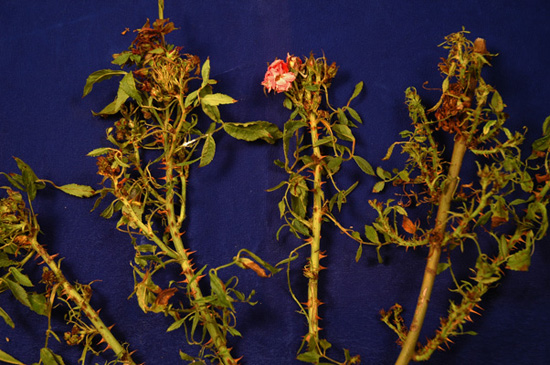Issue 14, August 14, 2009
Rose Rosette
Rose rosette is a lethal disease of roses that may look very much like chemical injury from a plant growth regulator herbicide. Unfortunately there is no lab test for rose rosette, so understanding symptom expression is helpful in deciding whether or not to remove a plant or change chemical application practices in the area.
Symptoms of rose rosette disease may include thick, often redder than normal stems with many times the normal number of thorns. Multiple stems at the ends of branches produce witches' broom growth and often small, distorted, and chlorotic leaves as seen in the image. Some herbicides may cause the witches' brooms, distorted growth, and discoloration, but they do not cause prolific production of thorns. Chemical injury usually follows a pattern of application or drift. When diagnosing rose rosette, investigate the use of herbicides in the area, including products applied nearby, on the lawn around the plants, and to the plants themselves. I have seen some cases of glyphosate applied in the fall around rose plants that absorbed it through thin bark and buds. Those roses looked like they had rose rosette the next spring, but only on the side next to the glyphosate application. Witches' brooms of strap shaped leaves may be caused by glyphosate, so beware.

Rose rosette disease often appears in new plants or in plants near new roses in the garden, possibly related to increases in population of the eriophyid mite vector. Infected plants cannot be cured and must be removed from the garden, roots and all. Waiting for the problem to go away will only allow it to spread further.
Rose rosette is caused by a double-stranded RNA, which means that it is a virus-like disease. It cannot be cultured in a lab and diagnosis relies on symptom expression. Plants usually die within about 22 months of infection. Multiflora, climbers, hybrid teas, floribundas, miniatures, and a number of old variety roses have been infected with rose rosette. Hybrid teas typically show color that is more yellow than red. So far, no other host besides rose has been found for rose rosette.
The presence of the vector may help with diagnosis. The vector of this disease is an eriophyid mite, a mite so small that 20 could fit on a pinhead. Eriophyid mites are much smaller than red spider mites which are commonly seen on plants. You can see these with a 10X or stronger power magnifying glass. In the lab we use a dissecting microscope to view the new growth. As we pick apart the buds the mites can be found scurrying away from the light and heat.
How would the rose rosette disease get into your garden? It could move in via eriophyid mites. It is more likely to come in on new plants. Consider isolating new roses until you are sure they are disease free. Grafting can also spread rose rosette disease. Infected plants cannot be salvaged. Plants with symptoms should be dug up and destroyed (including roots) when first noticed. It is strongly suggested that multiflora and garden roses be separated as far as possible from each other. The efficacy of mite control has been questioned in control of this disease. Research suggests that the critical mite transmission time is May and June, so concentrate your efforts in those months if you use a miticide.--Nancy Pataky
Author:
Nancy Pataky